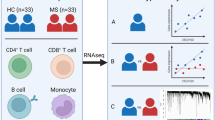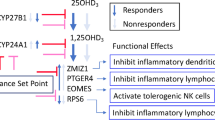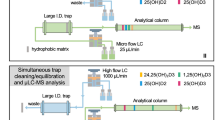Abstract
Multiple sclerosis, MS (OMIM No. 126200), is a complex inflammatory disease that is characterized by lesions in the central nervous system. Both genes and other environmental factors influence disease susceptibility. One of the environmental factors that has been implicated in MS and autoimmune disease, such as type 1 diabetes, is vitamin D deficiency, in which patients have lower levels of 25-hydroxyvitamin D3 (25-OHD3) in blood than do controls. Previtamin D3 is produced in the skin, and turned into 25-OHD3 in the liver. In the kidney, skin and immune cells, 25-OHD3 is turned into bioactive 1,25(OH)2D3 by the enzyme coded by CYP27B1 (cytochrome P450 family 27 subfamily B peptide 1) on chromosome 12q13.1–3. 1,25(OH)2D3 binds to the vitamin D receptor, expressed in T cells and antigen-presenting cells. 1,25(OH)2D3 has a suppressive role in the adaptive immune system, decreasing T-cell and dendritic cell maturation, proliferation and differentiation, shifting the balance between T-helper 1 (Th1) and Th2 cells in favor of Th2 cells and increasing the suppressive function of regulatory T cells. Rs703842 in the 12q13–14 region was associated with MS in a recent study by the Australian and New Zealand Multiple Sclerosis Genetics Consortium (ANZgene). We show associations with three SNPs in this region in our Swedish materials (2158 cases, 1759 controls) rs4646536, rs10877012 and rs10877015 (P=0.01, 0.01 and 3.5 × 10−3, respectively). We imputed rs703842 SNP and performed a joint analysis with the ANZgene results, reaching a significant association for rs703842 (P=5.1 × 10−11; odds ratio 0.83; 95% confidence interval 0.79–0.88). Owing to its close association with 25-OHD3, our results lend further support to the role of vitamin D in MS pathology.
Similar content being viewed by others
Log in or create a free account to read this content
Gain free access to this article, as well as selected content from this journal and more on nature.com
or
References
Kurtzke JF : Epidemiology of multiple sclerosis. Does this really point toward an etiology? Lectio Doctoralis. Neurol Sci 2000; 21: 383–403.
Acheson ED, Bachrach CA, Wright FM : Some comments on the relationship of the distribution of multiple sclerosis to latitude, solar radiation, and other variables. Acta Psychiatr Scand 1960; 35 (Suppl): 132–147.
van der Mei IA, Ponsonby AL, Blizzard L, Dwyer T : Regional variation in multiple sclerosis prevalence in Australia and its association with ambient ultraviolet radiation. Neuroepidemiology 2001; 20: 168–174.
Willer CJ, Dyment DA, Sadovnick AD, Rothwell PM, Murray TJ, Ebers GC : Canadian Collaborative Study Group. Timing of birth and risk of multiple sclerosis: population based study. BMJ 2005; 330: 120.
Bayes HK, Weir CJ, O’Leary C : Timing of birth and risk of multiple sclerosis in the Scottish population. Eur Neurol 2010; 63: 36–40.
Australian and New Zealand Multiple Sclerosis Genetics Consortium: Genome-wide association study identifies new multiple sclerosis loci on chromosomes 12 and 20. Nat Genet 2009; 41: 824–830.
Bailey R, Cooper JD, Zeitels L et al: Association of the vitamin D metabolism gene CYP27B1 with type 1 diabetes. Diabetes 2007; 56: 2616–2621.
Lopez ER, Regulla K, Pani MA, Krause M, Usadel KH, Badenhoop K : CYP27B1 polymorphisms variants are associated with type 1 diabetes mellitus in Germans. J Steroid Biochem Mol Biol 2004; 89–90: 115–157.
Lopez ER, Zwermann O, Segni M et al: A promoter polymorphism of the CYP27B1 gene is associated with Addison's disease, Hashimoto's thyroiditis, Graves’ disease and type 1 diabetes mellitus in Germans. (B) Eur J Endocrinol 2004; 151: 193–197.
Orton SM, Morris AP, Herrera BM et al: Evidence for genetic regulation of vitamin D status in twins with multiple sclerosis. Am J Clin Nutr 2008; 88: 441–447.
Smolders J, Damoiseaux J, Manheere P, Hupperts R : Vitamin D as an immune modulator in multiple sclerosis, a review. J Neuroimmunol 2008; 194: 7–17.
Gorman S, Kuritzky LA, Judge MA et al: Topically applied 1,25-dihydroxyvitamin D3 enhances the suppressive activity of CD4+CD25+ cells in the draining lymph nodes. J Immunol 2007; 179: 6273–6283.
van Etten E, Stoffels K, Gysemans C, Mathieu C, Overbergh L : Regulation of vitamin D homeostasis: implications for the immune system. Nutr Rev 2008; 66 (Suppl 2): S125–S134.
Munger KL, Levin LI, Hollis BW, Howard NS, Ascherio A : Serum 25-hydroxyvitamin D levels and risk of multiple sclerosis. JAMA 2006; 296: 2832–2838.
Smolders J, Thewissen M, Peelen E et al: Vitamin D status is positively correlated with regulatory T cell function in patients with multiple sclerosis. PLoS One 2009; 4: e6635.
Roos IM, Kockum I, Hillert J : The interleukin 23 receptor gene in multiple sclerosis: a case–control study. J Neuroimmunol 2008; 194: 173–180.
Hedström AK, Bäärnhielm M, Olsson T, Alfredsson L : Tobacco smoking, but not Swedish snuff use, increases the risk of multiple sclerosis. Neurology 2009; 73: 696–701.
de Bakker PI, Yelensky R, Péer I, Gabriel SB, Daly MJ, Altshuler D : Efficiency and power in genetic association studies. Nat Genet 2005; 37: 1217–1223.
Ekelund E, Saaf A, Tengvall-Linder M et al: Elevated expression and genetic association links the SOCS3 gene to atopic dermatitis. Am J Hum Genet 2006; 78: 1060–1065.
Li Y, Abecasis GR : Mach 1.0: rapid haplotyoe reconstruction and missing genotype inference. Am J Hum Genet 2006; S79: 416.
Dudbridge F : Likelihood-based association analysis for nuclear families and unrelated subjects with missing genotype data. Hum Hered 2008; 66: 87–98.
Lange EM, Sun J, Lange LA et al: Family-based samples can play an important role in genetic association studies. Cancer Epidemiol Biomarkers Prev 2008; 17: 2208–2214.
van der Mei IA, Ponsonby AL, Dwyer T et al: Vitamin D levels in people with multiple sclerosis and community controls in Tasmania, Australia. J Neurol 2007; 254: 581–590.
Ramos-Lopez E, Brück P, Jansen T, Pfeilschifter JM, Radeke HH, Badenhoop K : CYP2R1-, CYP27B1- and CYP24-mRNA expression in German type 1 diabetes patients. J Steroid Biochem Mol Biol 2007; 103: 807–810.
Ramagopalan SV, Maugeri NJ, Handunnetthi L et al: Expression of the multiple sclerosis-associated MHC class II allele HLA-DRB1*1501 is regulated by vitamin D. PLoS Genet 2009; 5: e1000369.
Acknowledgements
This study was supported financially by Neuropromise (LSHM-CT-2005-018637), Swedish Research Council, Swedish Foundation for the neurologically Disabled, the Söderberg foundation, Bibbi and Niels Jensens foundation, Swedish Council for Working life and Social Research, the Swedish Associations for Persons with Neurological Disabilities and the Montel Williams foundation.
Author information
Authors and Affiliations
Corresponding author
Ethics declarations
Competing interests
Ms Sundqvist reports no disclosures. Dr Bäärnhielm has received unrestricted research support from Biogen Idec and from Sanofi Aventis. Prof. Alfredsson receives research support from the Swedish Medical Research Council (K2007-69X-14973-04-3) and Swedish Council for Working life and Social Research (Dnr 2006-0655). Prof. Hillert has received unrestricted research support from BiogenIdec, MerckSerono and Bayer Schering. Prof. Olsson has received unrestricted research support from BiogenIdec, MerckSerono, SanofiAventis and Bayer Schering. Dr Kockum reports no disclosures.
Additional information
Supplementary Information accompanies the paper on European Journal of Human Genetics website
Supplementary information
Rights and permissions
About this article
Cite this article
Sundqvist, E., Bäärnhielm, M., Alfredsson, L. et al. Confirmation of association between multiple sclerosis and CYP27B1. Eur J Hum Genet 18, 1349–1352 (2010). https://doi.org/10.1038/ejhg.2010.113
Received:
Revised:
Accepted:
Published:
Issue date:
DOI: https://doi.org/10.1038/ejhg.2010.113
Keywords
This article is cited by
-
Vitamin D and Genetic Susceptibility to Multiple Sclerosis
Biochemical Genetics (2021)
-
Vitamin D receptor (VDR) gene polymorphism and risk of rheumatoid arthritis (RA): systematic review and meta-analysis
Clinical Rheumatology (2020)
-
Association between VDR polymorphisms and multiple sclerosis: systematic review and updated meta-analysis of case-control studies
Neurological Sciences (2018)
-
Interactions between genetic, lifestyle and environmental risk factors for multiple sclerosis
Nature Reviews Neurology (2017)
-
Does environmental confounding mask pleiotropic effects of a multiple sclerosis susceptibility variant on vitamin D in psychosis?
npj Schizophrenia (2015)



